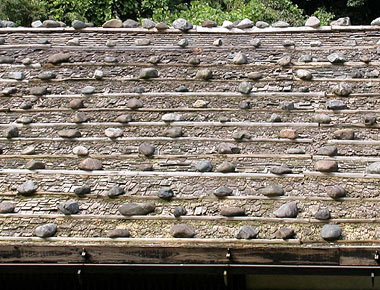Wood
shingles *itabuki Â, held
in position with stones. Generally used for roofs of vernacular houses *minka
ŊÆ, dating from the Edo period. Examples were numerous in mountainous areas
where material for thatch was not plentiful, and in urban areas where such
roofing was used for both town houses *machiya
ŽÆ and lesser military-class residences buke yashiki ÆŪ~. Ishioki
itabuki began to be replaced by tile in the last years of the Edo
period, particularly in large cities and in western Japan, but persisted
in Hokuriku kĪ, Chuubu , Touhoku k, and parts of Kantou Ö regions. In
some rural areas it was associated with vernacular houses of high status,
such as the houses in Nagano prefecture built in *honmune-zukuri
{Ē. Stones were used to hold the shingles in place as an alternative
to bamboo or metal nails, both of which would have been more time consuming
or expensive to obtain. When the shingles (manufactured according to the
hikiwari Ō system) were laid, the roofers, working from the eaves
up to the roof ridge, used lengths of timber to hold them down temporarily.
Afterwards round natural stones about the size of a human head were placed
at close intervals with lengths of timber laid horizontally beneath them
to prevent slippage. The roof form was generally gabled *kirizuma
yane ØČŪŠ. The roof pitch was as shallow as possible (about
3 or 3.5:10), and the bargeboard *hafu
j along the verges and the facia boards *hanakakushi-ita
@BÂ at the eaves were thick boards which projected slightly from the plane
of the roof to provide the stones and shingles with some protection against
high winds. It is clear from illustrated handscrolls *emaki
GŠ, and painted screens *byoubu-e
G that ishioki itabuki roofs were in use throughout the medieval
period, though the detail was somewhat different from that of the later
Edo period. In screens showing scenes in and around Kyoto *rakuchuu
rakugai-zu O}, for instance, stones are set securely into a bamboo
framework on town-house roofs of the yamato style *yamatobuki
åa.
|



